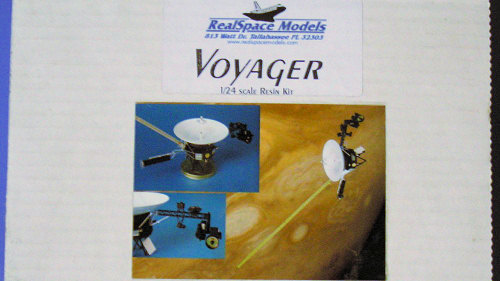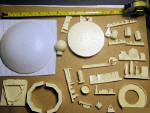
RealSpace Models 1/24 Voyager
| KIT: | RealSpace Models 1/24 Voyager |
| KIT #: | N/A |
| PRICE: | $60.00 |
| DECALS: | None |
| REVIEWER: | Kenn Hamm |
| NOTES: | Resin multi-media kit |

| HISTORY |
The Voyager program consists of two identical unmanned space probes called Voyager 1 and Voyager 2. They were originally to be part of the Mariner program as Mariner 11 and Mariner 12.
Voyager 2 was launched on August 20, 1977 and Voyager 1 was launched on September 5, 1997. Voyager 2 visited four planets (Jupiter, Saturn, Neptune, and Uranus) and their moons before crossing the termination shock which delineates what is considered the solar system. This achieved most of the “Planetary Grand Tour” plan by NASA and JPL to take advantage of a rare alignment of the four planets. Pluto was not included, but it turns out it isn’t a planet now anyway. As of August 2007, Voyager 2 is in the heliosheath and is more than more than 7.7 billion miles from earth, and is traveling at more than 303 million miles per year, or about 35,000 miles per hour.
Voyager 1 took a faster trajectory and visited the planets of Jupiter and Saturn and several moons. As of August 2007, it is more than 9.7 billion miles from earth and is traveling at about 38,500 miles per hour or more than 337 million miles per year. Voyager 1 is also in the heliosheath, and is the furthest man made object from Earth, and right now is actually more distant than any known object in the solar system.
Both Voyager probes are powered by radioisotope thermoelectric generators (RTGs), using Plutonium 238. They were originally producing 470 watts of power, but due to half-life decay and the decay of the thermocouples that convert the radioactive heat to energy, they are only producing about 290 watts each as of August, 2006. This means subsystems are turned off , but both probes still send data back to Earth. Both are expected to continue to operate until about 2020, though with a steady decline in their capabilities.
The Voyager probes both include a golden record that has images and sounds from earth, including greetings in 55 languages, music from around the world, and Uranium 238 electroplated on the cover to help determine the age of the probe. There is also some diagrams to show how to use the record and a rudimentary map locating our solar system in relation to 14 pulsars.
The probes have three CPUs each, running at 6.4MHz. Compare this to computers of September 2007 running at more than 3.2GHz. The probes communicate receive their uplink from Earth via S Band at 16 bits per second. They transmit using X-Band at 160 bits in normal operation or 1.4 kilobits per second when sending high-rate plasma wave data. Compare this to typical modem speeds of 33.6 and 56 kilobits per second, and high-speed internet at 3 megabits per second or better. Technology has come a long way in 30 years, but it is amazing that these two probes continue to operate in what must be the harshest of environments for so long.
| THE KIT |
 You get a sturdy corrugated cardboard
box with a photo of the finished kit from three perspectives, letting you know
you are in for something special. Inside, there are about 60 resin parts, two
large photo-etch frets, some wire and tubing, and the vacuformed antenna. The
resin bits are delivered in a bag made out of bubble wrap, and none of my parts
were broken upon delivery, or after having been moved about a few times since
joining my collection.
You get a sturdy corrugated cardboard
box with a photo of the finished kit from three perspectives, letting you know
you are in for something special. Inside, there are about 60 resin parts, two
large photo-etch frets, some wire and tubing, and the vacuformed antenna. The
resin bits are delivered in a bag made out of bubble wrap, and none of my parts
were broken upon delivery, or after having been moved about a few times since
joining my collection.
The resin is very hard. There is a lot of flash that will need to be removed, and the carrier blocks will require a razor saw in most cases due to the hardness of the resin and the fragility of the parts. There are some small pits that will need filling, but they are fairly few and far between. The detail on the resin is quite good.
 The tubes and wires will all need to
be cut, and the instructions have length guides to help you cut each part to the
right length.
The tubes and wires will all need to
be cut, and the instructions have length guides to help you cut each part to the
right length.
The photo-etched brass is very clean and is has decent detail. The bulk of the brass is for the booms and antennas.
The instructions are quite detailed yet written in a way to easily walk you through what is a very complicated build. All of the photo-etch folding instructions, paint information, tube lengths, and even an explanation of the record cover is included.
Finally, you can mount the finished model on an included base which is a replication of the record cover which is a nice touch for displaying your finished model.
| CONCLUSIONS |
This is not a kit for the faint of heart. It is relatively expensive and will require a lot of patience and skill. This one will sit on a shelf in my collection for a while, but when I feel confident I am ready to attempt it, I think it will result in a very rewarding build. If you are comfortable in resin and in folding detailed bits of brass, then I believe you will be very happy with this kit.
| REFERENCES |
Wikipedia – Voyager Program / Voyager 1 / Voyager 2
RealSpaceModels.com catalog – Voyager
September 2007
Kit courtesy of my wallet, purchased from RealSpaceModels.com.
If you would like your product reviewed fairly and quickly, please contact me or see other details in the Note to Contributors.